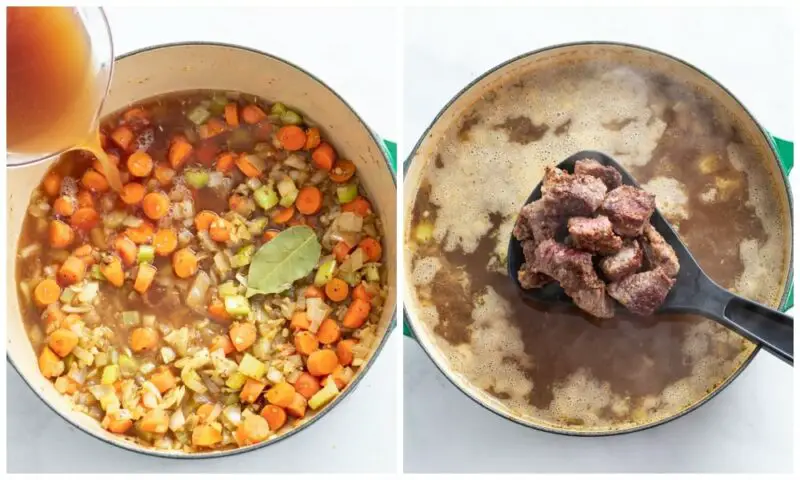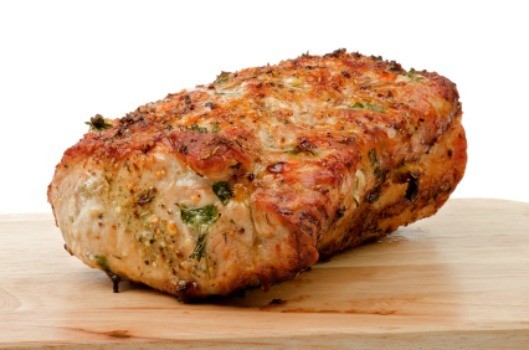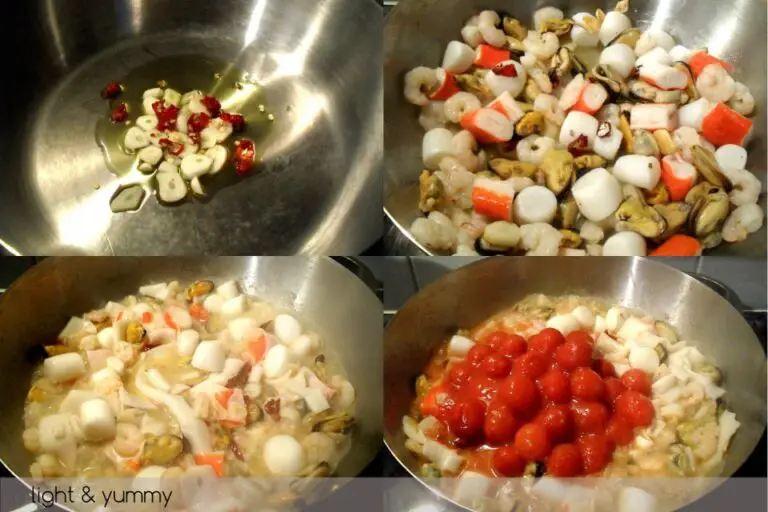When it comes to making soup, there are many things you need to consider. One of the first questions that often come up is whether or not to cook the meat before adding it to the soup. For some recipes, pre-cooking the meat is essential for the best possible texture and flavor. In this article, we will explore why you should cook meat before adding soup, ways to cook meat for soup, types of soups that require cooked meats, how to test if your meat is cooked properly, and best practices for cooking meats before adding soup.
Why Should You Cook Meat Before Adding Soup?
There are several reasons why it’s crucial to cook meat before adding it to soup. First and foremost, precooked meats have a better texture than raw meat cooked by boiling in broth. A precooked piece of meat starts with a brown crust that helps lock in all its juices and flavors while browning provides delicious caramelized notes on its surface. On the other hand, boiling a raw piece of meat in liquid leaves behind an oddly flabby texture because all moisture is leached out of it over time.
Moreover, cooking your meat before adding soup gives you another opportunity to layer depth into your dish when starting from real seared bits versus flat and dull boiled pieces.
Lastly but not least, cooking your meat separately enables you to drain off some excess fat which reduces the overall calorie count in your recipe.
Ways To Cook Meat For Soup
There are many ways to prepare meats before adding them into a pot of soup:
Conventional Stovetop Cooking Method
- Pan-Frying: This method is suitable for most cuts of beef, pork or chicken breasts. Simply season both sides with coarse salt & black pepper then heat a skillet over high heat with 1 tablespoon oil until hot. Add each piece separately onto the pan surface without overlapping. After about 3 minutes on one side (ideally when a brown crust forms), flip the meat over and cook to at least 138-140F (60C) for medium doneness. Otherwise, cook longer until it’s well done. Once cooked, transfer pieces to a plate, cover with foil, and rest for 10 minutes before slicing.
- Broiling: This process involves cooking meat on a rack that is placed directly under a super-heated broiler in an oven. It’s best used for thin cuts of beef or chicken thighs that can be marinated beforehand. Here is how: Marinate your meat beforehand with your chosen seasoning (e.g Cajun). Then Preheat your broiler on high and set the oven rack to near its highest level. Lay the marinated cuts on top of the roasting pans lined with cooking paper. Put in under the preheated broiler for 3-4 minutes one side then flip and broil the second side until crusty. Check the temperature with a thermometer when ready.
- Baking Meat For Soups: Another great way to prepare your meats for soup is by baking or roasting them first. This method works well for meats like lamb, pork shoulder or whole chickens:
Preheat oven 375F/190C Coat pieces with olive oil and seasonings as desired Pour some water into metal trays underneath to collect drippings Bake/roast until internal temperature reaches minimum recommended levels for doneness (e.g 170 F degrees Fahrenheit (77C )for chicken thighs)
Other Ways To Prep Your Meat Before Cooking
You can also try marinating or brining your meat before cooking it in order to add additional flavor layers. Marinating requires ingredients like lime or lemon juice, soy sauce, wine , vinegar, garlic cloves and various slices of onion along added spices e,g dried herb leaves,mustard powder etc..
Brining involves soaking meat in salt and a liquid like honey or molasses to break up the muscle fibers and improve tenderness, juiciness and flavor penetration.
Types Of Soups That Require Pre-Cooked Meat
The type of soup determines whether it is necessary to cook the meat before adding it. Soups that involve large pieces of vegetables or grains will typically require pre-cooked meats. For example, when making a big pot meal like chili con carne which contains beans, corn peeks or rice they usually merge with cooked ground chuck beef.
Other soups and broths need lean cuts of protein such as chicken breast that are initially seared first then set aside to be added later (e.g chicken noodle soup) which ensures that the mostly white meat stays moist as it cooks over time .
How To Test If Your Meat Is Cooked Properly
Before you add your cooked meat to the soup, you need to test if it’s cooked properly. Here are some ways to check:
- Appearance: The best way is by observing whether the color has turned its desired brownish tinge without any pink hints. Raw inner parts signify undercooking.
- Texture: Absent any gumminess, raw or overly chewy pieces suggests under-done elements
- Taste: When sufficiently well-done, the final taste should be more savory than plain boiled meat imparting depth of flavor specific to intended recipe ingredients.
To ensure accurate temperature readings with minimal touching remember using an instant-read thermometer offering results after inserting into thickest part of the cut piece.
Best Practices for Cooking Meats Before Adding Soup
Here are some best practices for cooking meat before adding soup:
Tips For Beginners On Choosing The Right Type And Quality Of Meat
- Always buy fresh quality meats from reputable butchers.
- Go for lean cuts free of excess fat whenever possible since soups already have plenty of water content.
Cutting Guide:
- Consider pre-trimming any large chunks of fat before cooking since any excess can cause your soup to taste oily or cloying.
- After cutting pieces, they are best prepared using methods that don’t overcrowd the pan / skillet or burning.
Extra Precautions When Cooking Red Meats
- When cooking red meats like beef or pork, it’s important to follow recommended minimum internal temperatures:
- Beef: Rare (120-125F/49-52C), Medium-rare (130-135F/55-57C), Medium (140F/60C), Medium-well (150F/65C) and Well done(160F being the highest end)
- Pork: medium rare at 145 F degrees Fahrenheit(63C) , and well-done at 160F degrees Fahrenheit(71C). For safer consumption , it is often encouraged to cook the meat well-done
Can You Add Raw Meat To Soup?
While some soups may require raw meat at some stages in their recipe preparation, it’s not typically recommended as cooked meat yields a better final dish. Additionally, Food safety experts would advise against adding raw meat directly into soup given its increased risk of food-borne illnesses due to bacteria thriving in warm moist environments. As such we do not recommend using raw meat for soup.
Conclusion
Pre-cooking your meat is crucial if you want the best results when adding it to your soup. Not only does cooking help lock in the flavor and ensure a better texture, but also delivers a safer experience by reducing health risks associated with undercooked meats. Remember always choose fresh quality cuts, cut off excess fat beforehand, use appropriate cooking methods while avoiding overcooking & overcrowding circumstances which hinders efficient browning.
Q&A
- Q: Should you always cook meat before adding it to soup? A: It depends on the type of meat and the recipe. Some meats can be added raw, such as ground beef or thinly sliced chicken, while tougher cuts may need to be cooked beforehand.
- Q: What are the benefits of cooking meat before adding it to soup? A: Cooking the meat beforehand can help to remove excess fat and make it more tender. It also ensures that the meat is cooked through properly and reduces the risk of foodborne illness.
- Q: Can you add precooked meat to soup? A: Absolutely! Precooked meats such as leftover chicken or ham can be a great addition to soups and stews. Just be sure to adjust your cooking time accordingly so that they don’t overcook.
- Q: Is there ever a reason not to cook meat before adding it to soup? A: In some traditional recipes, such as French onion soup or Vietnamese pho, the beef is added raw and allowed to simmer in the broth for hours until it is cooked through. However, these dishes are exceptions rather than the rule, and most recipes will call for pre-cooking the meat first for safety reasons.




